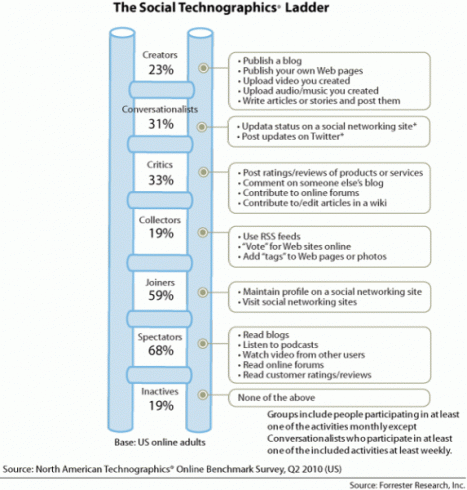
Last week Forrester Research published an update to their popular (and useful) Social Technographics report which showed that- depending on which pronouncements you read- seemed to indicate that online social activity had reached a plateau, or was even shrinking. Just a quick sample:
- PCWorld said: “This year, a smaller percentage of U.S. Internet users are contributing to social media sites” and argued that “companies need to find ways to re-engage those U.S. Internet users who have stopped participating on their social media sites”
- CNN reported that “the report . . . says people joining online social networks aren’t uploading videos, posting status updates and engaging in conversations like those before them”
- Raymond Nuez at the Huffington Post went so far as to title his piece “Where have all the content creators gone?”
- VerticalLeap in the UK went with “content generation activity fading among social network users“
- ReadWriteWeb summarized it as “Social networking users are creating less content” and followed Forrester’s Jacqueline Anderson in suggesting that this is cause for concern because (their subhead) “Fewer Creators Mean Fewer Ideas”
Arguably all the fuss has its origin in a blog post on Forrester’s site announcing the new report, which notes:
many groups in the US market plateaued. Creators, the group that is actually adding content to the Internet, are one example of this lack of growth.
(Though she does note they still represent 41 million US online adults). She goes on to conclude:
The story behind the data is pretty clear. The initial wave of consumers using social technologies in the US has halted. Companies will now need to devise strategies to extend social applications past the early adopters.
Looking at the numbers in the actual report, though, shows a much more muted story. Yes, the percentage of US Online Adults identified as creators did change from 24% to 23% between the 2009 survey and the 2010 survey. This is the core data point folks latched on to (this plus a change in critics from 37% to 33%, and a rise of inactives from 18% to 19%). But does this mean we’re all fresh out of new ideas? Nothing new being created on the web? No more activity from “the group that is actually adding content to the internet” (as opposed to merely commenting, repeating, critiquing, consuming, and lurking around)?

It helps to look at how the data is gathered and how users are categorized.
The data comes from an online survey of 26,913 US Adults. Given that (and a weighted sample size of 26,749), I’d argue that the difference between 2009 and 2010 is really quite minimal. In the methodology section of the report, Forrester notes:
For results based on a randomly chosen sample of this size (N = 26,913), there is 95% confidence that
the results have a statistical precision of plus or minus 1.4% of what they would be if the entire
population of US online individuals ages 18 and older had been surveyed.
The percentages of users in each category are created based on their response to a sequence of questions in the survey instrument which ask the users what activities they engage in on a regular basis. For example, (I believe this is the question used to determine the percentage of users who are “creators”):
74. ?There are many ways to put your own opinions, videos, music, and photos on the Internet. Which of the following activities do you do AT LEAST MONTHLY? (X ALL That Apply)
- Publish, maintain, or update a blog
- Upload video you created to a public Web site (e.g., YouTube, MySpace)
- Upload audio/music you created to a public Web site
- Post to photo-sharing sites (e.g., Snapfish, Flickr)
- Publish or update your own Web pages
- Write articles, stories, poems etc. and post them online (e.g., Gather, Helium)
- None of these
But notice how the question carves out what creation means. Also introduced between the 2009 survey and the 2010 survey was the category of “conversationalists” which is captured in this question, which immediately preceeded the one above:
73. There are also many ways to converse with others on the Internet. Which of the following activities do you do AT LEAST WEEKLY? (X ALL That Apply)
- Update your status on a social networking site (e.g., MySpace, Facebook, LinkedIn)
- Post updates on Twitter
- None of these
That group, which was not measured in 2009, is 33% of US Online Adults in the survey. But that’s not content creation, and doesn’t result in any new ideas in the internet pool? What about posting photos to Twitter (through TwitPic for example) or Facebook, as part of a status update? Is that conversation or creation? All those tweets don’t add up to enough new ideas or original content to equal a 1% shrink in the number of folks who maintain a regular blog?
It isn’t that the survey is a bad idea – I love the notion of tracking over time in a broad sense how people think of their participation in/on/throughout the internet – but that overgeneralizing about the results leads to bad conclusions. There may be a general shift away from traditional, stand-alone blogs (like this one) and in the direction of lighter-weight activity (status updates, microblogs, and tweets). Anyone who’s been active in any community (online or off) for a significant period of time recognizes that much of the work is done by few of the members, and it shouldn’t surprise anyone that not all internet users want to, have time to, or feel comfortable creating “original content” that fits a specific definition.
Should we expect 1 in 4 online US adults to maintain a regular stream of content creation? 1 in 5? 1 in 10? Even if 1 in 100 did so, would that mean that social activity and participation has ceased, or just changed forms (again)?

You can always share them just by pasting the url into FB.
It’s been on the list to add the “like” button functionality into WPBook but I haven’t gotten to it. Maybe instead I should just add another plugin which does that.